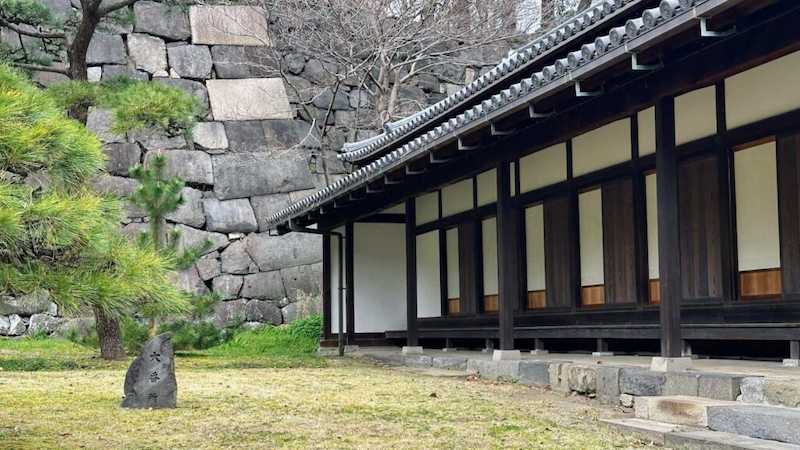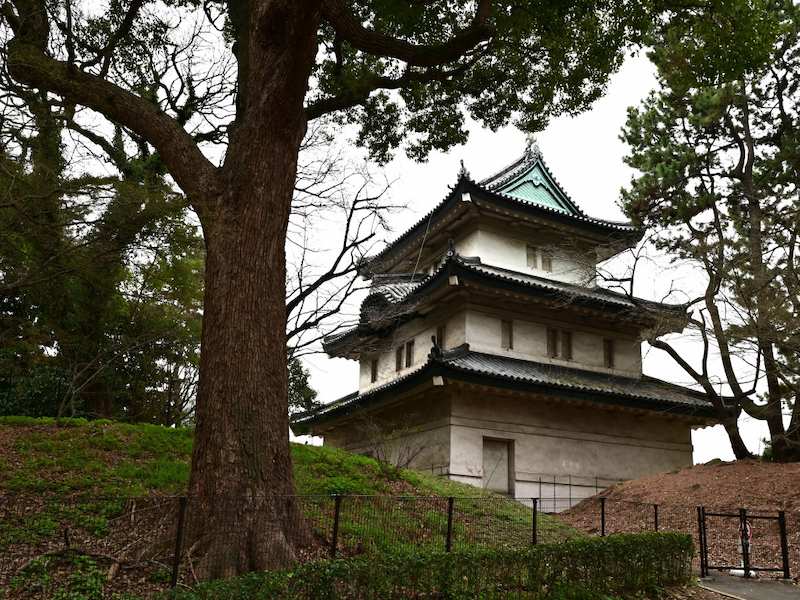After passing through Otemon Gate and exploring the strategically crucial Hyakunin-bansho guardhouse, we now step into the “Fujimi Yagura Area,” leading us towards the heart of the Honmaru (Main Keep). This section played a vital role in the defense and governance of the shogunate, with numerous historical remnants that still echo the grandeur of the Edo period.
Among the notable landmarks are the ruins of Nakanomon Gate and Obansho Guardhouse, which were heavily fortified, as well as the remnants of Chujakumon Gate, the final entrance leading to the shogun’s residence. Additionally, Fujimi Yagura, which symbolized the castle in place of the destroyed main keep, and the famous Matsuno-Ōrōka Hallway from the Chūshingura (The Treasury of Loyal Retainers) incident, are key sites that tell the story of the Tokugawa shogunate. As you explore this area, take a moment to appreciate the castle’s defensive ingenuity and the authority of the shogunate.
Fujimi Yagura Area
Nakanomon Gate Ruins
⭐ Recommended Rating
Historical :☆☆
Visual value:☆☆☆
Experiential:☆☆

The Nakanomon Gate once served as a major entrance to the Honmaru of Edo Castle. Throughout the Edo period, it was used by shoguns and feudal lords upon their arrival at the castle, and its strategic importance warranted strict security. Today, only the stone walls remain, offering a glimpse into the gate’s once-imposing structure.
| Item | Content |
|---|---|
| Year Built | Unknown |
| Builder | Unknown |
| Structure/Features | Remains of a gate; only stone walls survive |
| Renovation/Restoration | Unknown |
| Current Status | Stone walls remain |
| Destruction/Damage | Upper gate structure lost |
| Cultural Property Designation | Unknown |
| Remarks | – |
🗺 Address: 1-1 Chiyoda, Chiyoda-ku, Tokyo
🚶 Access: 1 minute walk from Hyakuninbansho (approx. 0.05km)
⏳ Recommended Visit Duration:
- Quick visit: About 5 minutes
- In-depth exploration: About 15 minutes
📍 Highlights
- Stone Wall Engineering: The Nakanomon ruins showcase the sophisticated stone masonry techniques of the Edo period.
- Surrounding Historical Structures: Nearby, you can also visit the Hyakunin-bansho and Obansho guardhouses to gain a deeper understanding of the castle’s security system.
📌 Trivia
- A Strategic Defense Point: The Nakanomon Gate was a heavily fortified area, crucial for the castle’s defense.
- Hidden Details: Some stones bear engravings of daimyo crests, indicating the clans responsible for maintenance and repairs.
Obansho Guardhouse
⭐ Recommended Rating
Historical :☆☆
Visual value:☆☆☆
Experiential:☆☆

The Obansho was a critical security post within Edo Castle, serving as the final checkpoint before entering the Honmaru. Positioned just inside the Otemon Gate and Nakanomon Gate, this guardhouse was manned by high-ranking samurai officers (yoriki and doshin) due to its strategic importance. The current structure was reconstructed in 1966 when the East Gardens of the Imperial Palace were opened to the public.
| Item | Content |
|---|---|
| Year Built | Unknown |
| Builder | Unknown |
| Structure/Features | Reconstructed guardhouse; rear steps (15 stone steps) used for defense remain |
| Renovation/Restoration | Reconstructed in 1966 |
| Current Status | Reconstructed building exists |
| Destruction/Damage | Unknown |
| Cultural Property Designation | Unknown |
| Remarks | – |
🗺 Address: 1-1 Chiyoda, Chiyoda-ku, Tokyo
🚶 Access: 1 minute walk from Nakanomon Gate (approximately 12m)
⏳ Recommended Visit Duration:
- Quick visit: About 5 minutes
- In-depth exploration: About 15 minutes
📍 Highlights
- Reconstructed Guardhouse: Experience a faithful reconstruction of the original Edo-period security facility.
- Shooting Steps: Behind the guardhouse, you’ll find 15 stone steps that were once used for archery and firearms defense.
📌 Trivia
- Overlooked Historic Spot: The shooting steps behind the Obansho are often missed by visitors, yet they offer a rare look into Edo Castle’s defensive measures.
Chujakumon Gate Ruins
⭐ Recommended Rating
Historical :☆☆
Visual value:☆☆☆
Experiential:☆☆

The Chujakumon Gate served as the main entrance to the Honmaru residence, where the shogun resided. It was the final checkpoint for feudal lords before they could enter the inner sanctum of the castle. Even high-ranking Tokugawa relatives had to dismount from their palanquins before passing through. Unfortunately, the gate was destroyed in the 1863 fire that consumed the Honmaru Palace, leaving only its stone foundation intact.
| Item | Content |
|---|---|
| Year Built | Unknown |
| Builder | Unknown |
| Structure/Features | Remaining stone walls and two zelkova trees mark the gate’s former location |
| Renovation/Restoration | Unknown |
| Current Status | Stone walls remain |
| Destruction/Damage | Destroyed by fire in 1863 |
| Cultural Property Designation | Unknown |
| Remarks | – |
🗺 Address: 1-1 Chiyoda, Chiyoda-ku, Tokyo
🚶 Access: 2 minutes walk from the guardhouse (about 100m)
⏳ Recommended Visit Duration:
- Quick visit: About 5 minutes
- In-depth exploration: About 10 minutes
📍 Highlights
- Stone Wall Remains: View the surviving stone walls that hint at the former grandeur of the gate.
- Keyaki Trees: Two towering zelkova trees mark the location of the former palace entrance.
- Seasonal Beauty: Cherry blossoms in spring and autumn foliage enhance the historic ambiance.
📌 Trivia
- Reused Stones: Some stones used in the Chujakumon walls originally came from the Edo Castle keep, which was destroyed in the 1657 Great Fire of Meireki.
- Scorched Remnants: Look closely, and you may find areas where the stones were discolored by the heat of the 1863 fire.
Fujimi Yagura (Tower)
⭐ Recommended Rating
Historical :☆☆☆
Visual value:☆☆☆
Experiential:☆☆☆

The Fujimi Yagura is one of the few remaining original structures of Edo Castle. This three-tiered watchtower, built in the early Edo period, was strategically placed for surveillance and defense. It was named “Fujimi” because, in the past, one could see Mount Fuji from its upper levels.
Take a 360° Look Around
| Item | Content |
|---|---|
| Year Built | Early Edo Period |
| Builder | Tokugawa Ieyasu |
| Structure/Features | Three-story turret with white plaster walls and black tiles |
| Renovation/Restoration | Originally rebuilt in 1659, it was destroyed during the Great Kanto Earthquake but reconstructed in 1925 using many of the original materials. |
| Current Status | Still existing |
| Destruction/Damage | Unknown |
| Cultural Property Designation | Unknown |
| Remarks | – |
🗺 Address: 1-1 Chiyoda, Chiyoda-ku, Tokyo
🚶 Access: About 3 minutes walk from Chujakumon ruins (about 0.1km)
⏳ Recommended Visit Duration:
- Quick visit: About 10 minutes
- In-depth exploration: About 20 minutes
📍 Highlights
- Striking Architecture: The contrast of white walls and black roof tiles showcases Edo-period aesthetics.
- Fortified Stone Walls: The sturdy base demonstrates the advanced construction techniques of the era.
- Seasonal Charm: Cherry blossoms in spring create a breathtaking scene with the watchtower.
📌 Trivia
- Symbol of Edo Castle: After the 1657 Great Fire of Meireki destroyed the main keep, the Fujimi Yagura became the de facto symbol of Edo Castle.
- Lost View of Mount Fuji: While the watchtower was originally named for its scenic view, modern buildings now obstruct the sightline.
Matsuno-Ōrōka Hallway Ruins
⭐ Recommended Rating
Historical :☆☆☆
Visual value:☆
Experiential:☆

The Matsu-no-Ōrōka (Great Pine Corridor) was a tatami-floored hallway located within the Honmaru Palace of Edo Castle. Measuring approximately 50 meters in total length—19 meters westward and 31 meters northward—and about 5 meters wide, the corridor featured sliding doors (fusuma) adorned with paintings of pine trees and plovers.This site is best known as the setting of the “Matsu-no-Rōka Incident,” which took place on March 14, 1701 (Genroku 14). On that day, Asano Naganori, the lord of the Akō Domain, drew his sword and attacked Kira Yoshinaka, a high-ranking court official, inside the corridor.
The incident ultimately led to the famous vendetta carried out by the Forty-seven Rōnin, known as the “Chūshingura”—one of Japan’s most enduring tales of loyalty and revenge.
Take a 360° Look Around
| Item | Content |
|---|---|
| Year Built | Unknown |
| Builder | Unknown |
| Structure/Features | Approx. 50m long, 4m wide corridor with tatami mats; once decorated with pine and plover paintings |
| Renovation/Restoration | Unknown |
| Current Status | Stone marker erected at the site |
| Destruction/Damage | Unknown |
| Cultural Property Designation | Unknown |
| Remarks | – |
🗺 Address: 1-1 Chiyoda, Chiyoda-ku, Tokyo
🚶 Access: 3 minutes walk from Fujimi Yagura (about 0.1km)
⏳ Recommended Visit Duration:
- Quick visit: About 5 minutes
- In-depth exploration: About 10 minutes
📍 Highlights
- Commemorative Stone Marker: Visit the stone monument marking the corridor’s location.
- Honmaru Ruins: Walk through the vast open area to imagine the grand scale of the Edo Castle complex.
📌 Trivia
- Cultural Impact: The 47 Ronin story has been immortalized in kabuki, films, and literature, cementing its place in Japanese history.
- Pine Motifs: The corridor’s iconic pine tree paintings were a defining feature of the Honmaru Palace interior.




comment